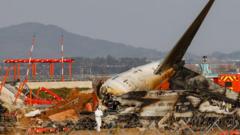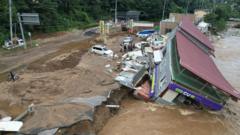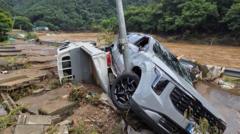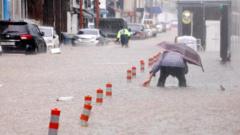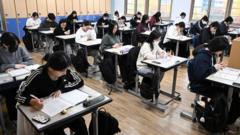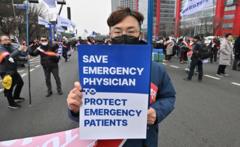Over the weekend, intense rainfall caused widespread devastation in South Korea, claiming 18 lives and displacing thousands as rescue efforts continue. The heavy rains brought about significant landslides and flooding, particularly impacting regions like Sancheong and Gapyeong County, where communities grapple with the aftermath of destruction.
Landslides and Floods Devastate South Korea: 18 Confirmed Dead

Landslides and Floods Devastate South Korea: 18 Confirmed Dead
At least 18 fatalities reported in South Korea as severe weather leads to landslides and flooding, with ongoing searches for the missing and a call for rebuilding efforts.
Rescue operations are ongoing in South Korea following torrential rains that have resulted in landslides and flooding, leading to 18 confirmed deaths. The disaster management office is working tirelessly to locate nine individuals still unaccounted for.
In the southern and western provinces of the country, more than 31 inches of rain have fallen since last Wednesday, with the Sancheong region being particularly hard hit, reporting 10 fatalities and several missing persons after a deluge led to road and infrastructure collapses. The local authorities had issued warnings to the 33,000 residents of these areas to remain vigilant about potential flooding and landslides.
Images from the scene depict devastating damage, with strawberry greenhouses destroyed and cars overturned in the debris. Residents, especially the elderly, face the challenge of navigating damage to their homes and daily lives. Power and water shortages have further complicated recovery efforts.
In a tragic incident in Gapyeong County, a family camping near a stream was caught in a landslide. Only the son survived, while rescue teams search for his mother and younger sister downstream. Meanwhile, the home ministry has reported the evacuation of approximately 14,000 people, with countless farms affected and massive casualties among livestock.
In response to the crises, President Lee Jae Myung declared special disaster zone status for the most affected areas, allowing for urgent government assistance. As the rains begin to subside, many evacuees are returning home, albeit to the daunting task of recovery. Soldiers have been deployed to aid in clearing debris and transporting damaged belongings.
Forecasts indicate ongoing challenges, with more rain expected in the central and northern regions. The combination of flooding and a potential heatwave in the south has prompted officials to take preventative measures against possible disease outbreaks in the wake of the disaster.
In the southern and western provinces of the country, more than 31 inches of rain have fallen since last Wednesday, with the Sancheong region being particularly hard hit, reporting 10 fatalities and several missing persons after a deluge led to road and infrastructure collapses. The local authorities had issued warnings to the 33,000 residents of these areas to remain vigilant about potential flooding and landslides.
Images from the scene depict devastating damage, with strawberry greenhouses destroyed and cars overturned in the debris. Residents, especially the elderly, face the challenge of navigating damage to their homes and daily lives. Power and water shortages have further complicated recovery efforts.
In a tragic incident in Gapyeong County, a family camping near a stream was caught in a landslide. Only the son survived, while rescue teams search for his mother and younger sister downstream. Meanwhile, the home ministry has reported the evacuation of approximately 14,000 people, with countless farms affected and massive casualties among livestock.
In response to the crises, President Lee Jae Myung declared special disaster zone status for the most affected areas, allowing for urgent government assistance. As the rains begin to subside, many evacuees are returning home, albeit to the daunting task of recovery. Soldiers have been deployed to aid in clearing debris and transporting damaged belongings.
Forecasts indicate ongoing challenges, with more rain expected in the central and northern regions. The combination of flooding and a potential heatwave in the south has prompted officials to take preventative measures against possible disease outbreaks in the wake of the disaster.

